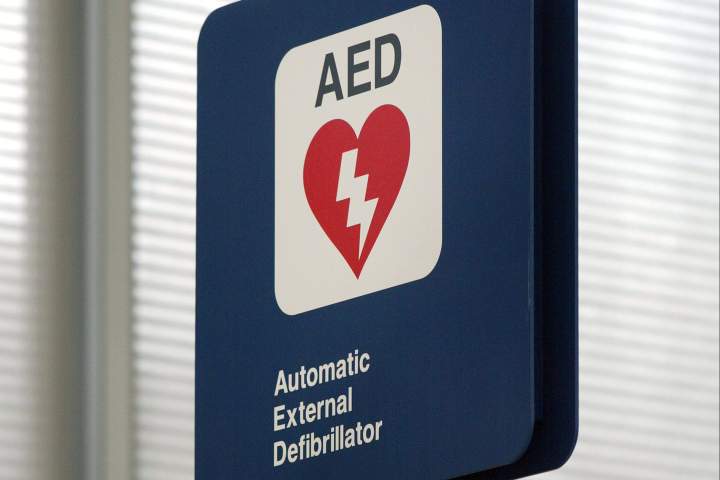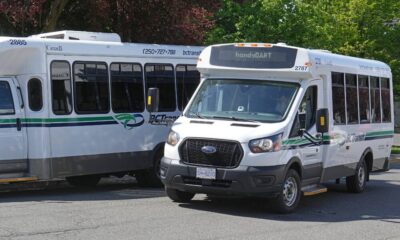Top Stories
B.C. Mandates AEDs, Naloxone in Schools by 2026 – Urgent Update

BREAKING: The British Columbia Ministry of Education has just announced a landmark mandate requiring all public schools to equip themselves with essential lifesaving tools: automated external defibrillators (AEDs) and naloxone kits. This critical policy aims to bolster health and safety in schools across the province, with high schools expected to comply by the end of 2023 and elementary schools by September 2026.
The urgent need for this policy was underscored by the advocacy of Tobias Zhang, a Grade 11 student from Point Grey Secondary in Vancouver, who rallied support after losing a friend to a cardiac event in 2022. His efforts, alongside his peers, prompted the Vancouver School Board (VSB) to implement a district-wide AED policy earlier this year. Now, the Ministry is extending this initiative provincewide.
“This is a significant victory for the Point Grey students who really advocated for this,” said Melnaie Cheng, chair of the Vancouver District Parent Advisory Council. The mandate also includes provisions for Grade 10 students to receive training in CPR and AED usage as part of their physical and health education curriculum, emphasizing the importance of equipping youth with critical life-saving skills.
While naloxone will be available in schools, students will not receive training on its use, a decision that has drawn criticism. Leslie McBain, co-founder of Moms Stop the Harm, expressed disappointment, stating,
“It is a shame, really, that they are not being given the training even basic overview of what it takes. Having kids know about naloxone, know what to do, know what an overdose looks like is a really good thing. They potentially will save lives.”
The provincial mandate requires schools to not only acquire but also regularly inspect and maintain AEDs. However, it does not include additional funding, raising concerns about how districts, particularly those without existing AED programs, will manage the financial burden. Currently, 97 percent of B.C. school districts have some AEDs in place. The VSB has allocated $250,000 for these lifesaving tools, but Trustee Jennifer Reddy acknowledged the ongoing financial strain on public schools:
“There’s no question public schools are underfunded and we’re being tasked to do more and more with less and less.”
As this policy rolls out, the provincial government is urged to work closely with school districts to address potential funding gaps and ensure that all schools can meet these new requirements without compromising other essential services.
This development marks a pivotal moment in educational health and safety in British Columbia, promising to save lives and empower students. Stay tuned for more updates on this urgent initiative as it unfolds across the province.
-

 Politics4 weeks ago
Politics4 weeks agoSecwepemc First Nation Seeks Aboriginal Title Over Kamloops Area
-

 World5 months ago
World5 months agoScientists Unearth Ancient Antarctic Ice to Unlock Climate Secrets
-

 Entertainment5 months ago
Entertainment5 months agoTrump and McCormick to Announce $70 Billion Energy Investments
-

 Science5 months ago
Science5 months agoFour Astronauts Return to Earth After International Space Station Mission
-

 Lifestyle5 months ago
Lifestyle5 months agoTransLink Launches Food Truck Program to Boost Revenue in Vancouver
-

 Technology3 months ago
Technology3 months agoApple Notes Enhances Functionality with Markdown Support in macOS 26
-

 Lifestyle3 months ago
Lifestyle3 months agoManitoba’s Burger Champion Shines Again Amid Dining Innovations
-

 Top Stories2 months ago
Top Stories2 months agoUrgent Update: Fatal Crash on Highway 99 Claims Life of Pitt Meadows Man
-

 Politics4 months ago
Politics4 months agoUkrainian Tennis Star Elina Svitolina Faces Death Threats Online
-

 Sports5 months ago
Sports5 months agoSearch Underway for Missing Hunter Amid Hokkaido Bear Emergency
-

 Politics5 months ago
Politics5 months agoCarney Engages First Nations Leaders at Development Law Summit
-

 Technology5 months ago
Technology5 months agoFrosthaven Launches Early Access on July 31, 2025




















